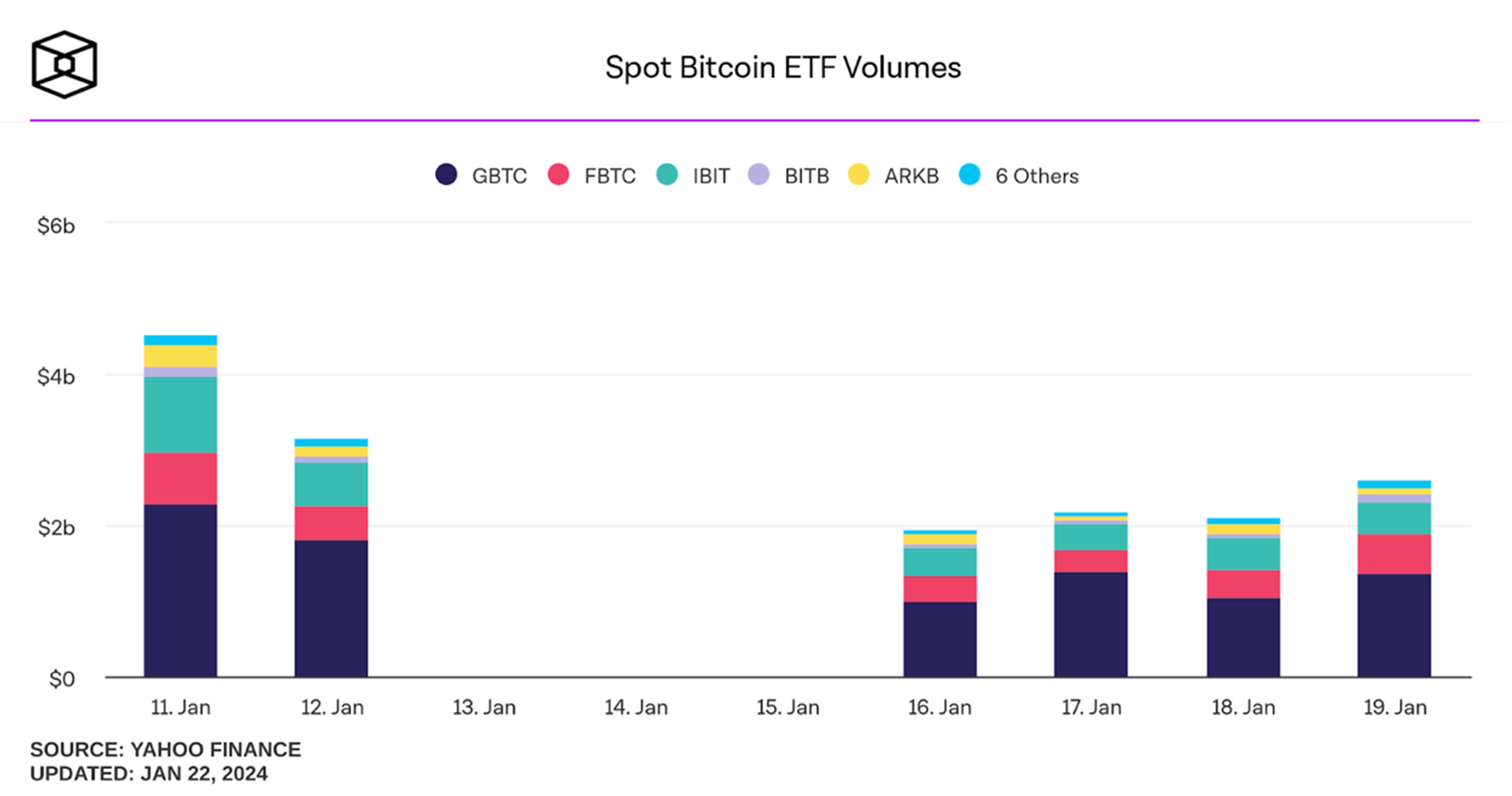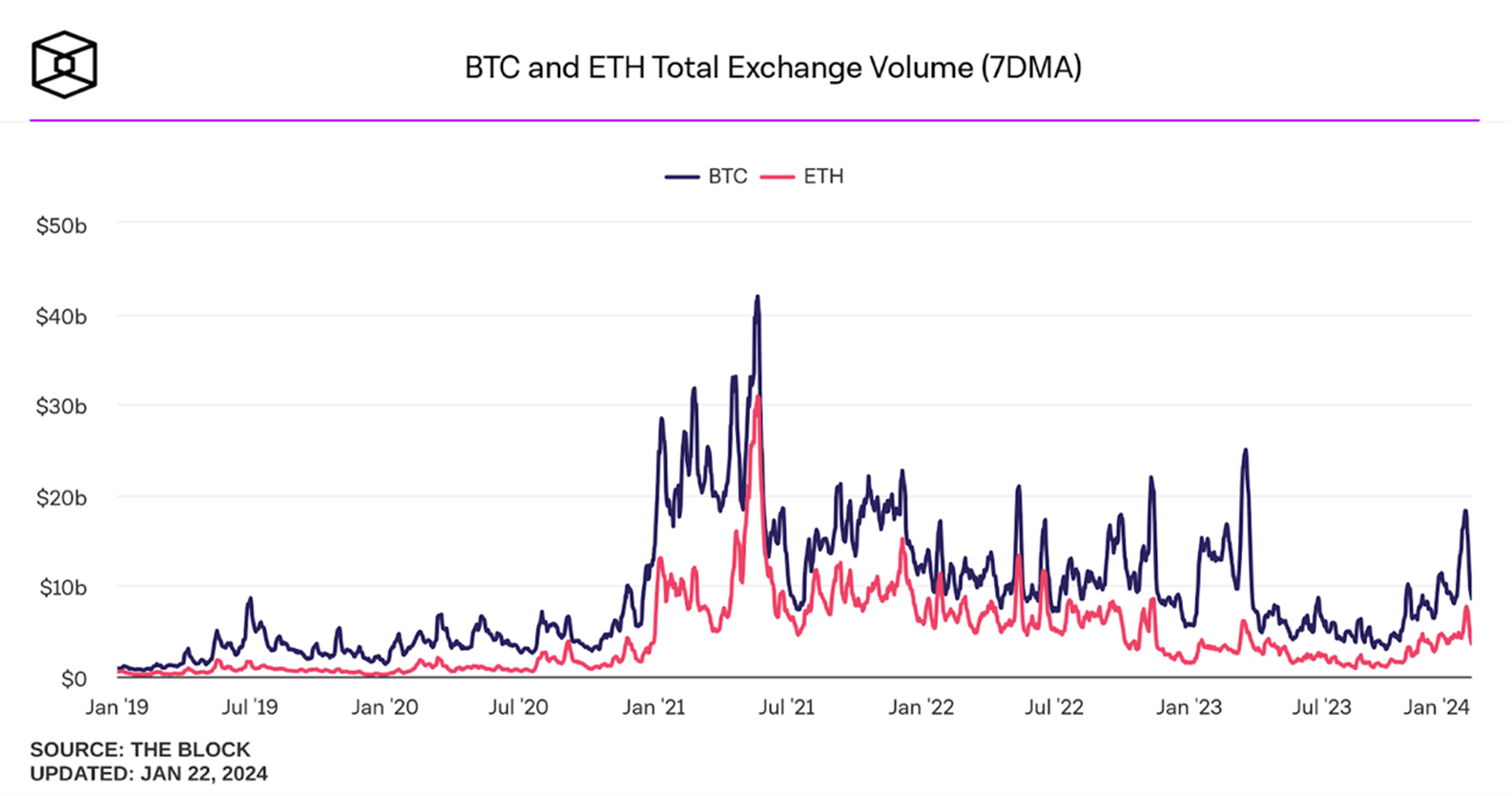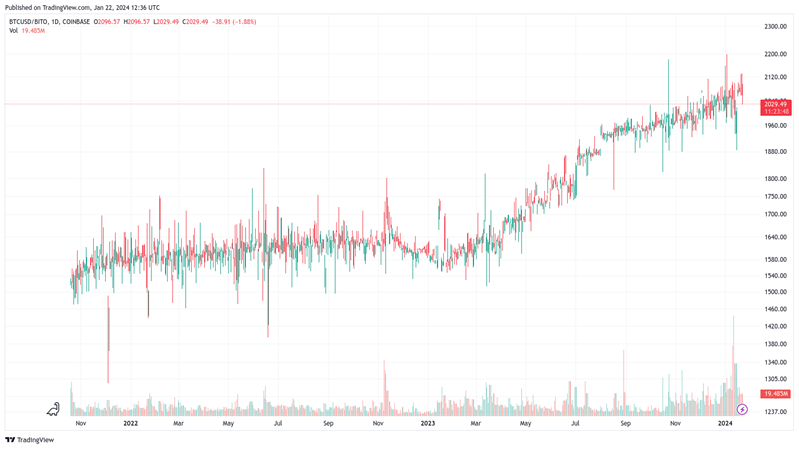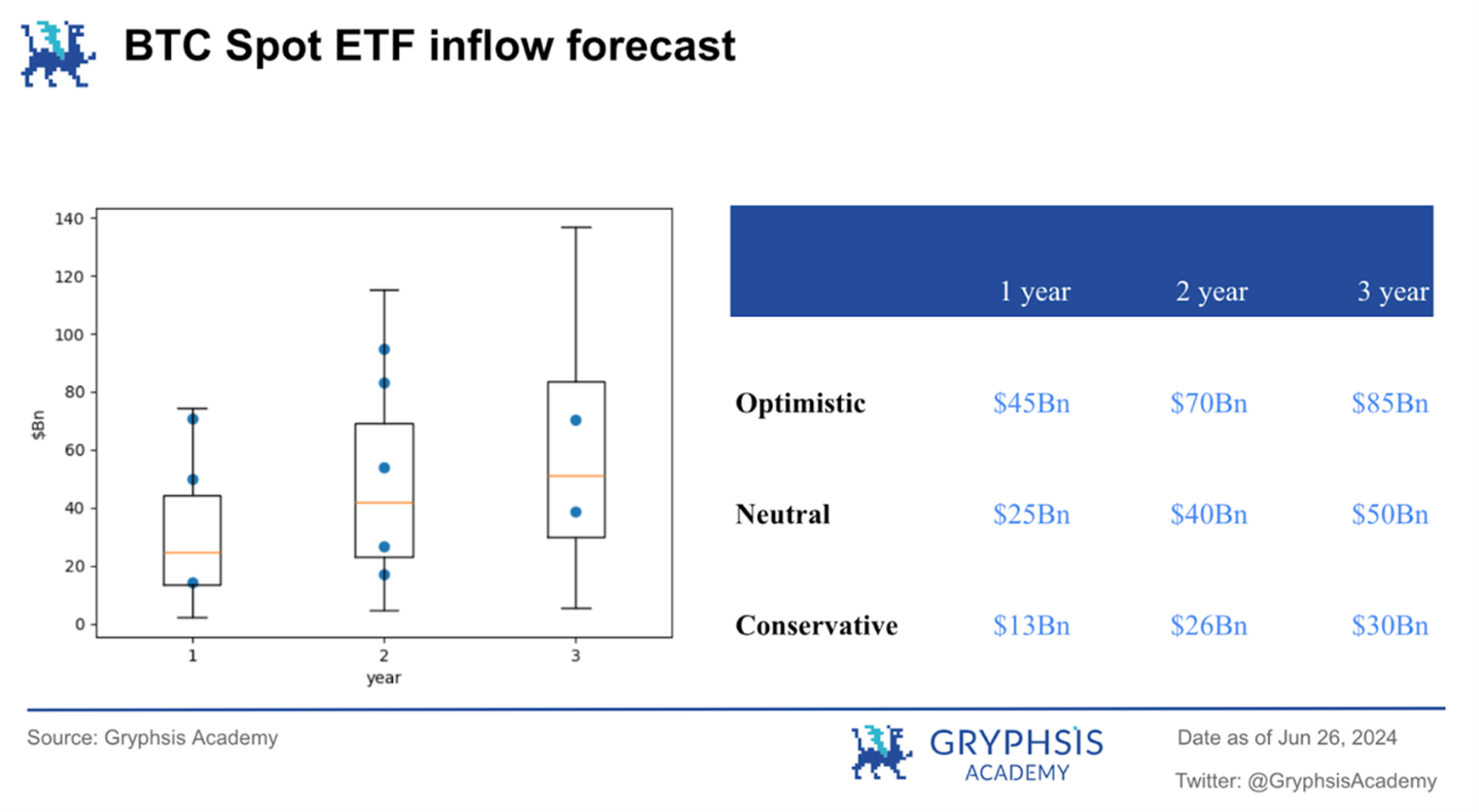Written by: @yutsingkuh
Mentors: @CryptoScottETH, @HaywarZhu_
1. Background
On January 10, 2024, the SEC approved the listing of Bitcoin spot ETF for the first time. A total of 11 Bitcoin ETFs were approved this time, with a total scale reaching 27 billion USD as of January 19 (the vast majority of which are shares of Grayscale's GBTC, converted from its original trust fund). However, this is not the first BTC spot ETF in the world. In 2021, the Purpose Bitcoin ETF was listed on the Toronto Stock Exchange. However, the United States is the world's largest capital market, and the SEC's approval will have a far greater impact on the market than in Canada.

The listing of BTC spot ETF is an important milestone in the development of Bitcoin. It will make Bitcoin investment more convenient and further increase the adoption rate of Bitcoin. Regular investors can invest in Bitcoin through their securities accounts without the need to open a cryptocurrency account. The risk control and compliance issues faced by Bitcoin investment will also be alleviated.
2. Current Market Situation
The price of BTC has risen significantly in the past three months, from $25,889 on September 10 to $46,106 on January 10, an increase of 78%. It is widely believed that the anticipation of BTC ETF approval is one of the main reasons for the price increase of BTC. After the approval of BTC ETF, the market performance has been relatively calm, possibly because the market had already anticipated this. When BTC ETF started trading for the first time, BTC briefly surged to $48,500, but then quickly fell back. As of January 17, the price of BTC was $42,800, a decrease of about 8% from before the approval of BTC ETF.
Although the fluctuation of BTC price is relatively moderate, BTC ETF has already had a huge impact on the market in just a few days. The trading volume of BTC ETF is huge, reaching $4.6 billion on the first day of listing. In comparison, the largest cryptocurrency exchange Binance had a spot trading volume of only $4.1 billion on the same day. This may be because the competition among market makers is more intense in traditional markets.


3. New Trading Factors
Due to the huge trading volume of Bitcoin spot ETF, it is likely to have a significant impact on the trend of Bitcoin. In the long run, Bitcoin spot ETF may become an important channel for incremental funds to enter, driving further upward movement of Bitcoin; in the short term, spot ETF adds new trading factors to the market.
The deep liquidity of Bitcoin spot ETF compared to traditional centralized exchanges implies significant arbitrage opportunities. On the one hand, there may be differences between the price of spot ETF and BTC spot price, which will bring arbitrage opportunities; on the other hand, differences in market structure during the opening and closing of the US stock market may also bring statistical arbitrage opportunities. These arbitrage opportunities will attract more funds and institutions to enter the cryptocurrency market.
Trading factors in the US stock market, such as market sentiment, market volatility, and market liquidity, may also affect the cryptocurrency market. The approval of Bitcoin spot ETF will make the trading factors in traditional markets more directly impact the cryptocurrency market. For example, the sentiment of investors in traditional markets may affect the short-term price of spot ETF, thereby affecting the BTC spot price. The impact of these factors may bring new trading strategies.
The cryptocurrency market is highly active and competitive. The inflow of funds into Bitcoin ETF as a driving force for long-term trends may not be directly related to the short-term trend of Bitcoin. Some public information in the market, such as the daily ETF fund inflow, has a lag. Investors should be cautious of the volatility risk in the cryptocurrency market and avoid blind trading.
4. Fund Inflow
4.1 Other Forecast Reports
Galaxy estimates that the fund inflow of BTC ETF will reach $14.4 billion in the first year, $26.5 billion in the second year, and $38.6 billion in the third year, based on the reach of BTC ETF on asset management platforms.
Glassnode estimates that BTC ETF will receive a fund inflow of $70.5 billion by referencing the scale of existing ETF products.
Standard Charted Research predicts that BTC ETF will receive a fund inflow of $50-100 billion in 2024.
4.2 Asset Allocation-based Forecast
Many studies have shown that including Bitcoin in asset allocation helps to increase the return of the portfolio and reduce volatility. This is because Bitcoin has a low correlation with traditional assets. However, for traditional investors, the threshold for investing in Bitcoin is relatively high. The approval of BTC ETF will make it more convenient for investors to include Bitcoin in asset allocation. Therefore, we can expect that the approval of BTC ETF will bring a large inflow of funds for asset allocation.
As early as 2019, a study by Aleh Tsyvinski suggested that 4%-6% of cryptocurrency should be included in the asset allocation. With the increasing adoption of BTC, its volatility risk is also decreasing. Wealth advisors typically recommend allocating 1%-5% to BTC. For a typical investor based on asset class allocation, such as investing in 40% stocks + 25% bonds + 10% gold + 25% cash, it is reasonable to include 3% of cryptocurrency in asset allocation. Compared to the current $1.27 trillion management scale of the S&P 500 index fund, we expect the scale of BTC ETF to reach $95 billion within two years.
4.3 Product Comparison-based Forecast
From an investment perspective, comparing with existing products can estimate the market demand for new products. Previously, the main products of the same type included the trust fund Grayscale Bitcoin Trust, the futures ETF ProShare Bit ETF, and the spot ETF Purpose Bitcoin ETF.
The significance of investing in BTC products lies in obtaining exposure to BTC. Management fees and tracking accuracy are the main considerations when investing in such products. The management fee determines the holding cost for investors, while the tracking accuracy determines the risk faced by investors. In actual products, the management fee is included in the net value. Therefore, such products can be seen as tools that pay the net value relative to the downward risk of BTC as a cost to obtain exposure to BTC. Under unchanged market conditions, this cost determines the demand of investors.
Assuming unchanged market conditions, the market consumption scale of BTC ETP-type products is expected to increase as the cost level decreases.

And the consumption scale is the product of the total position and cost.

Therefore, under the condition of reduced holding cost, the total position held by the market will at least increase inversely with the cost level.

Grayscale Bitcoin Trust is a trust fund, and its shares GBTC are held by Grayscale at a 1:1 ratio of BTC, charging a 2% annual management fee. GBTC shares can be traded on the secondary market but cannot be redeemed. The GBTC shares rapidly increased to 650,000 BTC from June 2020 to February 2021 and then stopped growing. For various reasons, the price of GBTC deviated significantly. Before February 2021, GBTC experienced a very high premium. Therefore, during this period, the demand for GBTC mainly came from the arbitrage space brought by the premium. After February 2021, GBTC faced a serious negative premium. Since it cannot be redeemed, the shares of GBTC did not decrease significantly. This does not reflect the actual market demand for GBTC. Therefore, GBTC cannot be used as a reference for predicting the demand for BTC ETF.

ProShare Bit ETF is a futures ETF, with its underlying assets mainly CME's BTC futures, with a current market value of $1.59 billion, the second largest BTC ETP after GBTC. Due to management fees and the cost of rolling futures, its net value lagged behind BTC by about 25% from October 2021 to January 2024. We believe that the annual holding cost of BITO is 13%. In comparison, the newly issued iShares Bitcoin Trust has a management fee of 0.25% per year, which is the current common management fee level for BTC ETFs. Therefore, the cost level of BITO is 52 times that of BTC ETF. Based on the above assumptions, the expected scale of BTC ETF is approximately 52 times that of BITO, or $83 billion. Considering the time needed for market equilibrium, we expect this to be achieved within two years.

Purpose Bitcoin ETF is a BTC spot ETF listed on the Toronto Stock Exchange in Canada and was once the largest BTC spot ETF. It was established in February 2021 and currently has a management scale of $1.5 billion. Considering that the total wealth management market in Canada in 2023 is $1.933 trillion, and the total wealth management market in the United States is $58.446 trillion. If the BTC spot ETF has the same participation level in the US market as in the Canadian market, its scale is expected to reach $45 billion. In addition, Statista predicts that the total wealth management market in the United States will grow by 10% in 2024, reaching $64.7 trillion. Based on this calculation, the scale of the BTC spot ETF by the end of 2024 is expected to reach $50 billion.
4.4 Comparison of Gold ETF and Bitcoin ETF
Gold ETF is the earliest commodity ETF and one of the most successful ETFs. Its scale has exceeded 10% of the gold market. Bitcoin is known as digital gold. It has similar characteristics to gold in terms of inflation resistance and store of value. The successful experience of gold ETF has certain reference value for predicting the scale of Bitcoin ETF, which is also a commodity ETF.
The first gold ETF in the United States, SPDR GLD, was listed in November 2004 and is still the largest gold ETF. After 1, 2, and 3 years of listing, its management scale reached $3.2 billion, $8.3 billion, $15 billion. Today, the total scale of global gold ETFs is approximately $235 billion. Considering that the market's acceptance of ETF products is much higher than in 2004, we expect BTC ETF to reach its mature scale earlier. Today, the total market value of gold is approximately $12 trillion, and the scale of gold ETF accounts for 2% of the total market value. The total market value of Bitcoin is approximately $840 billion. If the Bitcoin ETF accounts for the same proportion of market value, its scale will reach $17 billion.
Considering that gold has other uses besides its financial properties. We will make another comparison from the perspective of financial trading. The current trading volume of gold spot is approximately $130 billion per day, while the trading volume of Bitcoin spot is approximately $30 billion per day. Assuming that the relationship between the scale of Bitcoin ETF and the spot trading volume is the same as that of gold ETF, we expect the mature scale of Bitcoin ETF to be approximately $54 billion.
We assume that the above predictions will be achieved in 2 years.
4.5 Growth of Bitcoin Adoption
The approval of Bitcoin spot ETF is a significant market event. However, from the long-term development perspective of Bitcoin, this is just a small step towards its large-scale adoption. Many viewpoints believe that the adoption of BTC follows the theory of innovation diffusion, and currently BTC is still in the early stage of its development, at the top of the S-curve. In the past few years, many studies have used similar models to predict the growth of BTC adoption, and these predictions have been confirmed. The approval of Bitcoin ETF is the inevitable path for the growth of Bitcoin adoption and reaching more people. It significantly reduces the barrier to entry for investing in Bitcoin and is expected to become one of the main channels for Bitcoin investment in the coming years, as well as an important driving force for the growth of Bitcoin adoption.
4.6 Possible Shrinkage of GBTC
GBTC is currently the largest BTC spot ETF, converted from the previous trust fund. From 2022 to 2023, GBTC experienced a significant negative premium, attracting a large number of arbitrageurs, and some of this capital will flow out after the listing of BTC ETF. Considering that the negative premium of GBTC once approached 50%, there may be a flow out of nearly half of the capital. This part of the capital may flow into other Bitcoin ETFs, but it may not. However, it is quite difficult to estimate the impact of this on the growth of Bitcoin ETF scale.
5. Comprehensive Analysis
Based on the current market situation, we have made predictions for the scale of Bitcoin spot ETF from multiple independent perspectives. Combined with the existing market predictions, the timing and scale of all predictions are shown in the following figure. Assuming that the inflow speed of funds into Bitcoin ETF spot follows a log-normal distribution. After performing kernel density estimation on the known data points, we obtained the comprehensive results shown in the figure. The median and quartiles of the predictions represent optimistic, neutral, and conservative estimates. The final results are shown in the table below, expecting that within three years, in the optimistic scenario, the Bitcoin spot ETF will bring in $85 billion in fund inflow for Bitcoin, in the neutral scenario, it will bring in $50 billion, and in the pessimistic scenario, it will bring in $30 billion.

免责声明:本文章仅代表作者个人观点,不代表本平台的立场和观点。本文章仅供信息分享,不构成对任何人的任何投资建议。用户与作者之间的任何争议,与本平台无关。如网页中刊载的文章或图片涉及侵权,请提供相关的权利证明和身份证明发送邮件到support@aicoin.com,本平台相关工作人员将会进行核查。




